Exercise-Induced Muscle Damage and Protein Intake: A Bibliometric and Visual Analysis
Abstract
:1. Introduction
2. Materials and Methods
2.1. Search Strategy and Data Collection
2.2. Measures
2.3. Data Analysis and Software
3. Results
3.1. Publication Outputs and Citations
3.2. Contributions of Countries and Institutions
3.3. Author and Co-Cited Authors
3.4. Journals and Co-Cited Journals
3.5. References and Co-Cited References
3.6. Analysis of Keywords
4. Discussion
4.1. Research Sources
4.2. Research Topics
- Exercise modes. Exercise modes that can result in EIMD and/or DOMS include long-distance running [81], resistance exercise [82], high-intensity intermittent exercise [83], and downhill running [84]. Eccentric contractions cause more severe symptoms than isolated or concentric contractions [1]. Muscle-damaging exercise modes are also classified as aerobic exercise and strength training [13]. Interestingly, both our clustering results (#10 one-off soccer match, #3 match-related fatigue, #11 athletic performance injury, and #17 progressive resistance exercise) and recent studies revealed that the effect of specific sports (e.g., soccer [85] and basketball [86]) on muscle damage is a research focus. This implies that specific sports with greater ecological validity are receiving increased attention. We believe that improving the ecological validity of studies for better application can provide useful insights into how to avoid cumulative fatigue and overtraining, as well as lower the risk of injury. While the preceding studies [85,86] examined muscle damage, their primary purpose was to review or investigate the effects of a one-off match (combined with supplementation) on athletic performance. From this perspective, the reduced risk of injury and improved human performance in real-world settings [85,86,87] broaden the application scenarios of “exercise modes”. Another application is performing an unusual eccentric exercise that triggers the so-called “repetitive bout effect (RBE)”, which has been shown to be a protective adaptive response that significantly reduces EIMD [88]. Therefore, as an important research topic, “exercise mode” has evolved from human- and animal-tested exercise protocols to the current training and intervention model.
- Nutritional strategies and recovery techniques. Co-citation clustering (#0, #2, #9, #13, and #20), as well as several high-cited and high-co-cited references [33,34,36,89], and keyword clustering (Figure 7B) all pointed to “nutritional strategies” as one of the most dominant research topics in the field of EIMD and protein intake. Not only is “diet strategies” (#0) the top-ranked co-citation cluster, but it is also widely accepted that optimal nutritional supplementation is essential for muscle repair and regeneration [90].
- Specifically, branched-chain amino acids (BCAA) are effective supplements for reducing muscle damage and accelerating recovery after exercise [32,35]. β-Hydroxy-β-methylbutyrate (HMB), a BCAA metabolite, has gained popularity as a human nutritional supplement, particularly among strength athletes [91], by preventing muscle protein degradation and muscle damage during intense training [10]. Another promising strategy for reducing muscle damage is the combination of carbohydrates and protein (e.g., carbohydrate–protein beverages) [33,34]. Furthermore, in the context of nutritional strategies, the parallel to nutritional supplements is diet and food. The importance of diet and food is supported by the top ten co-cited references (three studies using milk or Montmorency cherry) and co-citation clusters [33,34,36,89]. Diet and food containing various ingredients (clusters #9 nitrate-rich beetroot juice and #20 grandiflorum-derived saponin) have also been studied to alleviate EIMD [66,92]. Overall, diet and food are a more practical and secure alternative to supplements for athletes to prevent unintentional doping [93]. It is also worth noting that when conducting a clinical trial (e.g., nutritional changes or massage), it has become standard practice to use a randomized, double-blind, and placebo study design whenever possible to avoid expectations (bias) of main and subject/participant effects. Therefore, double-blind placebo was identified as a significant cluster (#13) for this research topic. Finally, skeletal muscle inflammation and soreness are frequently treated with non-nutritive recovery techniques, such as massage and cold-water immersion [16,17]. Although physical recovery techniques were not included in the clustering of co-cited references and keywords, two highly cited studies [16,17] were among the top ten cited references. Combining the evidence presented above and considering the practical applications of physical recovery techniques in the field of sports and fitness (likely accompanied by EIMD or DOMS), it is reasonable to conclude that non-nutrition treatments are a promising research topic. Intriguingly, the potential mechanisms by which physical recovery techniques affect EIMD or DOMS, as well as whether they interact with nutritional supplements, need to be investigated further. To summarize, gaining a comprehensive understanding of nutritional strategies to alleviate EIMD symptoms and accelerate recovery [6,10] is the predominant research objective.
- Beneficial outcomes. As previously stated, the EIMD- and DOMS-related “exercise mode” and “nutritional strategies” are becoming more application-oriented. This implies that “beneficial outcomes” will inevitably receive more attention, as evidenced by cluster #5 (practical application), which is provided by Peake et al.’s review [31]. Cluster #1 (skeletal muscle hypertrophy) demonstrates that muscle inflammation and increased protein turnover during EIMD recovery are required for long-term hypertrophic adaptations [14]. Peake et al.’s review concluded that EIMD and the subsequent inflammatory responses are unavoidable because both are thought to be essential components of muscle repair [31]. Furthermore, as evidenced by the top-cited and top co-cited references (Table 2 and Table 3), numerous application-based studies on training interventions and nutritional supplements have highlighted their beneficial outcomes. Measures of exercise performance (muscle strength, vertical jump, and speed), muscle function and muscle cell morphology (muscle cell and subcellular disruptions, muscle swelling, and cytoskeletal muscle fiber components), the inflammatory response (leukocyte count, C-reactive protein, cytokines, and interleukin-6), enzymes (creatine kinase and lactate dehydrogenase), and hormones/metabolites are the main components included (cortisol, testosterone, thiobarbituric acid-reactive substances, protein carbonyls, and uric acid). Given the previous findings, the role of EIMD in muscle function and hypertrophy is an especially intriguing research hotspot.
- Taking all of the above outcomes into account, the role of EIMD in muscle function and hypertrophy is an intriguing research hotspot. Muscle hypertrophy, for example, can benefit the elderly’s health by preventing the onset of sarcopenia and (or) muscle atrophy [94]. Therefore, this research topic is supported by a large number of beneficial outcomes. However, transferring the beneficial effects from the laboratory to the clinic remains a challenge.
- Proposed mechanisms. Exploring the underlying mechanisms of EIMD or DOMS has always been regarded as an important research topic. It is widely accepted that the complex damage model can be divided into two phases: the initial phase, or primary damage, that results from the mechanical and metabolic stress caused by an exercise bout, and secondary damage that propagates tissue damage via processes associated with the inflammatory response [9]. Numerous studies, as evidenced by the clusters of co-citations and keywords (Figure 6 and Figure 7), concentrated on oxidative stress and inflammation, which are thought to be EIMD contributing factors but are also required for recovery and adaptation processes [6,11]. It is also important to recognize muscle protein functions (co-citation cluster #16 obscurin) and pro-inflammatory cytokine gene expression (cluster #7 messenger RNA and keyword cluster #7 nociceptor interleukin). Finally, assessing the efficacy of the proposed EIMD-associated-protein mechanisms assists researchers in determining the precise effect of various nutritional and therapeutic strategies on EIMD reduction and recovery [4,13].
4.3. Frontiers and Future Directions
- The foundation of muscle hypertrophy and protein supplements. In recent years, investigating whether or not EIMD is related to muscle hypertrophy appears to be cutting-edge, as the frontier keywords “protein synthesis” and “eccentric exercise” have an association with muscle hypertrophy. Although muscle hypertrophy can occur in the absence of muscle damage [95,96], increased exercise-induced reactive oxygen species (ROS) and inflammatory responses are more commonly associated with muscle hypertrophy and are attracting researchers’ attention. Muscle adaptation necessitates low-to-moderate-exercise-induced ROS production; if it exceeds a certain threshold, not only do the physiological benefits diminish, but muscle damage worsens [97]. Although post-exercise oxidative stress and inflammation are important for both recovery and adaptation [11], long-term nutritional interventions that rely too heavily on these two factors have not resulted in the expected improvement in muscle adaptation [6]. Moreover, the trade-off between recovery and adaptation varies depending on the primary goal of the session. To optimize the “beneficial outcomes”, for example, a periodized approach to nutrition should be fully considered to adequately support exercise/training in order to achieve a balance between the potential for recovery and adaptation [6,12]. This might be partially supported by the concept of exercise-induced hormesis theory, which purports that biological systems respond with a bell-shaped curve [97,98]. Furthermore, the first half of the “stratification” of burst references (2014–2019) in Figure 6A reflects and corroborates this. Therefore, it is likely to become a research frontier that applies the concept of hormesis of nutritional supplementation to various training purposes, training phases, fitness levels, genders, and ages and then applies these findings in real-world scenarios.
- In practice, however, a single theory and/or hypothesis has limited explanatory power when the cause–effect relationship is not proven. More research is needed to confirm that there is a link between muscle damage and hypertrophy [14] and to investigate the potential dose–response relationship. The optimal level for determining muscle damage caused by hypertrophy can be determined in this direction. Thus, we believe that “exercise modes” and “nutritional strategies” are important in activating antioxidants, DNA repair, and protein-degrading enzymes. It is more than just muscle recovery and adaptation and includes, perhaps more subtly, oxidative stress-related diseases and, more broadly, aging.
- Potential mechanisms of muscle fiber and muscle membrane damage. Applied research is frequently supported by basic science. Aside from the aforementioned applied research, the evidence presented below has a common but easily overlooked theme: the “stratification” of citation burst references (2003–2010, Figure 6B), which have been continuously followed and cited until now. Influential basic studies can be found in high-impact journals (Nature, FASEB J, Free Radic Biol Med, and Am J Physiol) [99,100,101,102]. Furthermore, studies published in high-impact journals (Figure 5A) and the bursts of keywords (expression, metabolism, and protein synthesis; Figure 7B) all focused on the morphological hallmarks of eccentric-contraction-induced injury and/or the protective effect of nutritional supplements, such as the myofibrillar Z-disc, α-actin, and the cytoskeleton (desmin, titin, nebulin, dystrophin, dysferlin, and so on) [8,67,103,104]. Since studies published in high-centrality journals such as Nature [101,102] revealed that the most common human muscular myopathy (Duchenne muscular dystrophy) is caused by a lack of dystrophin on the cytoplasmic surface of the skeletal muscle membrane, cytoskeleton proteins have been the focus. Furthermore, cytoskeleton degradation is an important potential mechanism of muscle damage/EIMD [8,67,103,104]. Accordingly, despite significant research contributions to EIMD, the precise mechanisms causing muscle damage, soreness, repair, and adaptation remain speculative, calling for further research.
4.4. Limitations
5. Conclusions
Supplementary Materials
Author Contributions
Funding
Institutional Review Board Statement
Informed Consent Statement
Data Availability Statement
Acknowledgments
Conflicts of Interest
References
- Clarkson, P.M.; Hubal, M.J. Exercise-induced muscle damage in humans. Am. J. Phys. Med. Rehabil. 2002, 81, S52–S69. [Google Scholar] [CrossRef] [PubMed]
- Clarkson, P.M.; Nosaka, K.; Braun, B. Muscle function after exercise-induced muscle damage and rapid adaptation. Med. Sci. Sports Exerc. 1992, 24, 512–520. [Google Scholar] [CrossRef] [PubMed]
- Brown, S.; Day, S.; Donnelly, A. Indirect evidence of human skeletal muscle damage and collagen breakdown after eccentric muscle actions. J. Sports Sci. 1999, 17, 397–402. [Google Scholar] [CrossRef] [PubMed]
- Peake, J.M.; Roberts, L.A.; Figueiredo, V.C.; Egner, I.; Krog, S.; Aas, S.N.; Suzuki, K.; Markworth, J.F.; Coombes, J.S.; Cameron-Smith, D.; et al. The effects of cold water immersion and active recovery on inflammation and cell stress responses in human skeletal muscle after resistance exercise. J. Physiol. 2017, 595, 695–711. [Google Scholar] [CrossRef] [Green Version]
- Cheung, K.; Hume, P.; Maxwell, L. Delayed onset muscle soreness: Treatment strategies and performance factors. Sports Med. 2003, 33, 145–164. [Google Scholar] [CrossRef]
- Owens, D.J.; Twist, C.; Cobley, J.N.; Howatson, G.; Close, G.L. Exercise-induced muscle damage: What is it, what causes it and what are the nutritional solutions? Eur. J. Sport Sci. 2019, 19, 71–85. [Google Scholar] [CrossRef]
- Hyldahl, R.D.; Hubal, M.J. Lengthening our perspective: Morphological, cellular, and molecular responses to eccentric exercise. Muscle Nerve 2014, 49, 155–170. [Google Scholar] [CrossRef]
- Yu, J.G.; Liu, J.X.; Carlsson, L.; Thornell, L.E.; Stal, P.S. Re-evaluation of sarcolemma injury and muscle swelling in human skeletal muscles after eccentric exercise. PLoS ONE 2013, 8, e62056. [Google Scholar] [CrossRef] [Green Version]
- McHugh, M.P. Recent advances in the understanding of the repeated bout effect: The protective effect against muscle damage from a single bout of eccentric exercise. Scand. J. Med. Sci. Sports 2003, 13, 88–97. [Google Scholar] [CrossRef]
- Howatson, G.; van Someren, K.A. The prevention and treatment of exercise-induced muscle damage. Sports Med. 2008, 38, 483–503. [Google Scholar] [CrossRef]
- Sousa, M.; Teixeira, V.H.; Soares, J. Dietary strategies to recover from exercise-induced muscle damage. Int. J. Food Sci. Nutr. 2014, 65, 151–163. [Google Scholar] [CrossRef] [PubMed]
- Bongiovanni, T.; Genovesi, F.; Nemmer, M.; Carling, C.; Alberti, G.; Howatson, G. Nutritional interventions for reducing the signs and symptoms of exercise-induced muscle damage and accelerate recovery in athletes: Current knowledge, practical application and future perspectives. Eur. J. Appl. Physiol. 2020, 120, 1965–1996. [Google Scholar] [CrossRef] [PubMed]
- Markus, I.; Constantini, K.; Hoffman, J.R.; Bartolomei, S.; Gepner, Y. Exercise-induced muscle damage: Mechanism, assessment and nutritional factors to accelerate recovery. Eur. J. Appl. Physiol. 2021, 121, 969–992. [Google Scholar] [CrossRef] [PubMed]
- Schoenfeld, B.J. Does exercise-induced muscle damage play a role in skeletal muscle hypertrophy? J. Strength Cond Res. 2012, 26, 1441–1453. [Google Scholar] [CrossRef] [PubMed] [Green Version]
- Baumert, P.; Lake, M.J.; Stewart, C.E.; Drust, B.; Erskine, R.M. Genetic variation and exercise-induced muscle damage: Implications for athletic performance, injury and ageing. Eur. J. Appl. Physiol. 2016, 116, 1595–1625. [Google Scholar] [CrossRef] [Green Version]
- Crane, J.D.; Ogborn, D.I.; Cupido, C.; Melov, S.; Hubbard, A.; Bourgeois, J.M.; Tarnopolsky, M.A. Massage therapy attenuates inflammatory signaling after exercise-induced muscle damage. Sci. Transl. Med. 2012, 4, 119ra113. [Google Scholar] [CrossRef] [Green Version]
- Bailey, D.M.; Erith, S.J.; Griffin, P.J.; Dowson, A.; Brewer, D.S.; Gant, N.; Williams, C. Influence of cold-water immersion on indices of muscle damage following prolonged intermittent shuttle running. J. Sports Sci. 2007, 25, 1163–1170. [Google Scholar] [CrossRef]
- Nakagawa, S.; Samarasinghe, G.; Haddaway, N.R.; Westgate, M.J.; O’Dea, R.E.; Noble, D.W.A.; Lagisz, M. Research weaving: Visualizing the future of research synthesis. Trends Ecol. Evol. 2019, 34, 224–238. [Google Scholar] [CrossRef] [Green Version]
- Chen, J.; Xue, X.; Xu, J.; Zeng, J.; Xu, F. Emerging trends and hotspots in tai chi fall prevention: Analysis and visualization. Int. J. Environ. Res. Public Health 2022, 19, 8326. [Google Scholar] [CrossRef]
- Xu, F.; Xu, J.; Zhou, D.; Xie, H.; Liu, X. A bibliometric and visualization analysis of motor learning in preschoolers and children over the last 15 years. Healthcare 2022, 10, 1415. [Google Scholar] [CrossRef]
- Cortese, S.; Sabe, M.; Chen, C.; Perroud, N.; Solmi, M. Half a century of research on attention-deficit/hyperactivity disorder: A scientometric study. Neurosci. Biobehav. Rev. 2022, 140, 104769. [Google Scholar] [CrossRef] [PubMed]
- Hirsch, J.E. An index to quantify an individual’s scientific research output. Proc. Natl Acad Sci. USA 2005, 102, 16569–16572. [Google Scholar] [CrossRef] [PubMed] [Green Version]
- Small, H. Co-citation in the scientific literature: A new measure of the relationship between two documents. J. Am. Soc. Inf. Sci. 1973, 24, 265–269. [Google Scholar] [CrossRef]
- Hofmann, T.; Puzicha, J. Statistical Models for Co-Occurrence Data; Massachusetts Institute of Technology: Cambridge, MA, USA, 1998. [Google Scholar]
- White, H.D.; McCain, K.W. Visualizing a discipline: An author co-citation analysis of information science, 1972–1995. J. Am. Soc. Inf. Sci. 1998, 49, 327–355. [Google Scholar]
- Chen, C. Searching for intellectual turning points: Progressive knowledge domain visualization. Proc. Natl. Acad. Sci. USA 2004, 101, 5303–5310. [Google Scholar] [CrossRef] [PubMed] [Green Version]
- Pedersen, B.K.; Ostrowski, K.; Rohde, T.; Bruunsgaard, H. The cytokine response to strenuous exercise. Can. J. Physiol. Pharmacol. 1998, 76, 505–511. [Google Scholar] [CrossRef]
- Bradford, M.M. A rapid and sensitive method for the quantitation of microgram quantities of protein utilizing the principle of protein-dye binding. Anal. Biochem. 1976, 72, 248–254. [Google Scholar] [CrossRef]
- Friden, J.; Lieber, R.L. Eccentric exercise-induced injuries to contractile and cytoskeletal muscle fibre components. Acta Physiol. Scand. 2001, 171, 321–326. [Google Scholar] [CrossRef] [Green Version]
- Ispirlidis, I.; Fatouros, I.G.; Jamurtas, A.Z.; Nikolaidis, M.G.; Michailidis, I.; Douroudos, I.; Margonis, K.; Chatzinikolaou, A.; Kalistratos, E.; Katrabasas, I.; et al. Time-course of changes in inflammatory and performance responses following a soccer game. Clin. J. Sport Med. 2008, 18, 423–431. [Google Scholar] [CrossRef]
- Peake, J.M.; Neubauer, O.; Della Gatta, P.A.; Nosaka, K. Muscle damage and inflammation during recovery from exercise. J. Appl. Physiol. 2017, 122, 559–570. [Google Scholar] [CrossRef]
- Shimomura, Y.; Murakami, T.; Nakai, N.; Nagasaki, M.; Harris, R.A. Exercise promotes bcaa catabolism: Effects of BCAA supplementation on skeletal muscle during exercise. J. Nutr. 2004, 134, 1583S–1587S. [Google Scholar] [CrossRef]
- Cockburn, E.; Stevenson, E.; Hayes, P.R.; Robson-Ansley, P.; Howatson, G. Effect of milk-based carbohydrate-protein supplement timing on the attenuation of exercise-induced muscle damage. Appl. Physiol. Nutr. Metab. 2010, 35, 270–277. [Google Scholar] [CrossRef] [PubMed]
- Cockburn, E.; Hayes, P.R.; French, D.N.; Stevenson, E.; St Clair Gibson, A. Acute milk-based protein-cho supplementation attenuates exercise-induced muscle damage. Appl. Physiol. Nutr. Metab. 2008, 33, 775–783. [Google Scholar] [CrossRef]
- Shimomura, Y.; Yamamoto, Y.; Bajotto, G.; Sato, J.; Murakami, T.; Shimomura, N.; Kobayashi, H.; Mawatari, K. Nutraceutical effects of branched-chain amino acids on skeletal muscle. J. Nutr. 2006, 136, 529S–532S. [Google Scholar] [CrossRef] [PubMed] [Green Version]
- Bell, P.G.; Walshe, I.H.; Davison, G.W.; Stevenson, E.; Howatson, G. Montmorency cherries reduce the oxidative stress and inflammatory responses to repeated days high-intensity stochastic cycling. Nutrients 2014, 6, 829–843. [Google Scholar] [CrossRef] [PubMed] [Green Version]
- Close, G.L.; Ashton, T.; Cable, T.; Doran, D.; Noyes, C.; McArdle, F.; MacLaren, D.P. Effects of dietary carbohydrate on delayed onset muscle soreness and reactive oxygen species after contraction induced muscle damage. Br. J. Sports Med. 2005, 39, 948–953. [Google Scholar] [CrossRef] [PubMed] [Green Version]
- Saunders, M.J.; Kane, M.D.; Todd, M.K. Effects of a carbohydrate-protein beverage on cycling endurance and muscle damage. Med. Sci. Sports Exerc. 2004, 36, 1233–1238. [Google Scholar] [CrossRef] [PubMed] [Green Version]
- Harty, P.S.; Cottet, M.L.; Malloy, J.K.; Kerksick, C.M. Nutritional and supplementation strategies to prevent and attenuate exercise-induced muscle damage: A brief review. Sports Med. Open 2019, 5, 1. [Google Scholar] [CrossRef]
- Fatouros, I.G.; Jamurtas, A.Z. Insights into the molecular etiology of exercise-induced inflammation: Opportunities for optimizing performance. J Inflamm. Res 2016, 9, 175–186. [Google Scholar] [CrossRef] [Green Version]
- Bell, P.G.; Stevenson, E.; Davison, G.W.; Howatson, G. The effects of montmorency tart cherry concentrate supplementation on recovery following prolonged, intermittent exercise. Nutrients 2016, 8, 441. [Google Scholar] [CrossRef] [PubMed] [Green Version]
- Damas, F.; Nosaka, K.; Libardi, C.A.; Chen, T.C.; Ugrinowitsch, C. Susceptibility to exercise-induced muscle damage: A cluster analysis with a large sample. Int. J. Sports Med. 2016, 37, 633–640. [Google Scholar] [CrossRef]
- Bell, P.G.; Walshe, I.H.; Davison, G.W.; Stevenson, E.J.; Howatson, G. Recovery facilitation with montmorency cherries following high-intensity, metabolically challenging exercise. Appl. Physiol. Nutr. Metab. 2015, 40, 414–423. [Google Scholar] [CrossRef] [Green Version]
- Yu, J.G.; Carlsson, L.; Thornell, L.E. Evidence for myofibril remodeling as opposed to myofibril damage in human muscles with DOMS: An ultrastructural and immunoelectron microscopic study. Histochem Cell Biol. 2004, 121, 219–227. [Google Scholar] [CrossRef]
- Yuan, Z.M.; Li, M.; Ji, C.Y.; Li, L.; Jia, L.; Incecik, A. Steady hydrodynamic interaction between human swimmers. J. R. Soc. Interface 2019, 16, 20180768. [Google Scholar] [CrossRef] [PubMed] [Green Version]
- Twist, C.; Eston, R. The effects of exercise-induced muscle damage on maximal intensity intermittent exercise performance. Eur. J. Appl. Physiol. 2005, 94, 652–658. [Google Scholar] [CrossRef] [PubMed]
- Baty, J.J.; Hwang, H.; Ding, Z.; Bernard, J.R.; Wang, B.; Kwon, B.; Ivy, J.L. The effect of a carbohydrate and protein supplement on resistance exercise performance, hormonal response, and muscle damage. J. Strength Cond. Res. 2007, 21, 321–329. [Google Scholar] [PubMed] [Green Version]
- White, J.P.; Wilson, J.M.; Austin, K.G.; Greer, B.K.; St John, N.; Panton, L.B. Effect of carbohydrate-protein supplement timing on acute exercise-induced muscle damage. J. Int. Soc. Sports Nutr. 2008, 5, 5. [Google Scholar] [CrossRef] [PubMed] [Green Version]
- Betts, J.A.; Toone, R.J.; Stokes, K.A.; Thompson, D. Systemic indices of skeletal muscle damage and recovery of muscle function after exercise: Effect of combined carbohydrate-protein ingestion. Appl. Physiol. Nutr. Metab. 2009, 34, 773–784. [Google Scholar] [CrossRef] [PubMed]
- Green, M.S.; Corona, B.T.; Doyle, J.A.; Ingalls, C.P. Carbohydrate-protein drinks do not enhance recovery from exercise-induced muscle injury. Int. J. Sport Nutr. Exerc. Metab. 2008, 18, 1–18. [Google Scholar] [CrossRef] [PubMed] [Green Version]
- Howatson, G.; McHugh, M.P.; Hill, J.A.; Brouner, J.; Jewell, A.P.; van Someren, K.A.; Shave, R.E.; Howatson, S.A. Influence of tart cherry juice on indices of recovery following marathon running. Scand. J. Med. Sci. Sports 2010, 20, 843–852. [Google Scholar] [CrossRef] [PubMed]
- Choi, J.H.; Jin, S.W.; Kim, H.G.; Choi, C.Y.; Lee, H.S.; Ryu, S.Y.; Chung, Y.C.; Hwang, Y.J.; Um, Y.J.; Jeong, T.C.; et al. Saponins, especially platyconic acid A, from platycodon grandiflorum reduce airway inflammation in ovalbumin-induced mice and PMA-exposed A549 cells. J. Agric. Food Chem. 2015, 63, 1468–1476. [Google Scholar] [CrossRef] [PubMed]
- Hutchison, A.T.; Flieller, E.B.; Dillon, K.J.; Leverett, B.D. Black currant nectar reduces muscle damage and inflammation following a bout of high-intensity eccentric contractions. J. Diet. Suppl. 2016, 13, 1–15. [Google Scholar] [CrossRef] [PubMed]
- Machado, A.F.; Ferreira, P.H.; Micheletti, J.K.; de Almeida, A.C.; Lemes, I.R.; Vanderlei, F.M.; Netto Junior, J.; Pastre, C.M. Can water temperature and immersion time influence the effect of cold water immersion on muscle soreness? A systematic review and meta-analysis. Sports Med. 2016, 46, 503–514. [Google Scholar] [CrossRef] [PubMed] [Green Version]
- Kanda, K.; Sugama, K.; Hayashida, H.; Sakuma, J.; Kawakami, Y.; Miura, S.; Yoshioka, H.; Mori, Y.; Suzuki, K. Eccentric exercise-induced delayed-onset muscle soreness and changes in markers of muscle damage and inflammation. Exerc. Immunol. Rev. 2013, 19, 72–85. [Google Scholar] [PubMed]
- Xiao, K.; Chen, Y.; Jiang, X.; Tyagi, V.K.; Zhou, Y. Characterization of key organic compounds affecting sludge dewaterability during ultrasonication and acidification treatments. Water Res. 2016, 105, 470–478. [Google Scholar] [CrossRef]
- Clark, K.A.; McElhinny, A.S.; Beckerle, M.C.; Gregorio, C.C. Striated muscle cytoarchitecture: An intricate web of form and function. Annu. Rev. Cell Dev. Biol. 2002, 18, 637–706. [Google Scholar] [CrossRef] [PubMed] [Green Version]
- Howatson, G.; Hoad, M.; Goodall, S.; Tallent, J.; Bell, P.G.; French, D.N. Exercise-induced muscle damage is reduced in resistance-trained males by branched chain amino acids: A randomized, double-blind, placebo controlled study. J. Int. Soc. Sports Nutr. 2012, 9, 20. [Google Scholar] [CrossRef] [PubMed] [Green Version]
- Greer, B.K.; Woodard, J.L.; White, J.P.; Arguello, E.M.; Haymes, E.M. Branched-chain amino acid supplementation and indicators of muscle damage after endurance exercise. Int. J. Sport Nutr. Exerc. Metab. 2007, 17, 595–607. [Google Scholar] [CrossRef]
- Jackman, S.R.; Witard, O.C.; Jeukendrup, A.E.; Tipton, K.D. Branched-chain amino acid ingestion can ameliorate soreness from eccentric exercise. Med. Sci. Sports Exerc. 2010, 42, 962–970. [Google Scholar] [CrossRef]
- Ascensao, A.; Rebelo, A.; Oliveira, E.; Marques, F.; Pereira, L.; Magalhaes, J. Biochemical impact of a soccer match—Analysis of oxidative stress and muscle damage markers throughout recovery. Clin. Biochem. 2008, 41, 841–851. [Google Scholar] [CrossRef] [PubMed]
- Baird, M.F.; Graham, S.M.; Baker, J.S.; Bickerstaff, G.F. Creatine-kinase- and exercise-related muscle damage implications for muscle performance and recovery. J. Nutr. Metab. 2012, 2012, 960363. [Google Scholar] [CrossRef]
- Nikolaidis, M.G.; Jamurtas, A.Z.; Paschalis, V.; Fatouros, I.G.; Koutedakis, Y.; Kouretas, D. The effect of muscle-damaging exercise on blood and skeletal muscle oxidative stress: Magnitude and time-course considerations. Sports Med. 2008, 38, 579–606. [Google Scholar] [CrossRef] [PubMed]
- Nosaka, K.; Sacco, P.; Mawatari, K. Effects of amino acid supplementation on muscle soreness and damage. Int. J. Sport Nutr. Exerc. Metab. 2006, 16, 620–635. [Google Scholar] [CrossRef] [PubMed] [Green Version]
- Tipton, K.D.; Elliott, T.A.; Cree, M.G.; Aarsland, A.A.; Sanford, A.P.; Wolfe, R.R. Stimulation of net muscle protein synthesis by whey protein ingestion before and after exercise. Am. J. Physiol. Endocrinol. Metab. 2007, 292, E71–E76. [Google Scholar] [CrossRef]
- Clifford, T.; Bell, O.; West, D.J.; Howatson, G.; Stevenson, E.J. The effects of beetroot juice supplementation on indices of muscle damage following eccentric exercise. Eur. J. Appl. Physiol. 2016, 116, 353–362. [Google Scholar] [CrossRef]
- Yu, J.G.; Furst, D.O.; Thornell, L.E. The mode of myofibril remodelling in human skeletal muscle affected by DOMS induced by eccentric contractions. Histochem. Cell Biol. 2003, 119, 383–393. [Google Scholar] [CrossRef] [PubMed]
- Saltin, B.; Grimby, G. Physiological analysis of middle-aged and old former athletes. Comparison with still active athletes of the same ages. Circulation 1968, 38, 1104–1115. [Google Scholar] [CrossRef] [PubMed] [Green Version]
- Saltin, B.; Helge, J.W. Metabolic capacity of skeletal muscles and health. Ugeskr. Laeger. 2000, 162, 2159–2164. [Google Scholar] [PubMed]
- Bangsbo, J.; Graham, T.E.; Kiens, B.; Saltin, B. Elevated muscle glycogen and anaerobic energy production during exhaustive exercise in man. J. Physiol. 1992, 451, 205–227. [Google Scholar] [CrossRef]
- Bangsbo, J.; Johansen, L.; Graham, T.; Saltin, B. Lactate and H+ effluxes from human skeletal muscles during intense, dynamic exercise. J. Physiol. 1993, 462, 115–133. [Google Scholar] [CrossRef] [PubMed]
- Bangsbo, J.; Johansen, L.; Quistorff, B.; Saltin, B. NMR and analytic biochemical evaluation of CRP and nucleotides in the human calf during muscle contraction. J. Appl. Physiol. 1993, 74, 2034–2039. [Google Scholar] [CrossRef] [PubMed]
- Friden, J.; Lieber, R.L.; Thornell, L.E. Subtle indications of muscle damage following eccentric contractions. Acta Physiol. Scand. 1991, 142, 523–524. [Google Scholar] [CrossRef] [PubMed]
- Malm, C. Exercise-induced muscle damage and inflammation: Fact or fiction? Acta Physiol. Scand. 2001, 171, 233–239. [Google Scholar] [CrossRef]
- Malm, C.; Yu, J.G. Exercise-induced muscle damage and inflammation: Re-evaluation by proteomics. Histochem. Cell Biol. 2012, 138, 89–99. [Google Scholar] [CrossRef] [PubMed]
- Vihko, V.; Salminen, A.; Rantamaki, J. Exhaustive exercise, endurance training, and acid hydrolase activity in skeletal muscle. J. Appl. Physiol. Respir. Environ. Exerc. Physiol. 1979, 47, 43–50. [Google Scholar] [CrossRef] [PubMed]
- Vihko, V.; Salminen, A. Damage of skeletal muscle tissue during physical stress. Duodecim 1979, 95, 1683–1694. [Google Scholar] [PubMed]
- Schwane, J.A.; Watrous, B.G.; Johnson, S.R.; Armstrong, R.B. Is lactic acid related to delayed-onset muscle soreness? Phys. Sportsmed. 1983, 11, 124–131. [Google Scholar] [CrossRef] [PubMed]
- Stedge, H.L.; Armstrong, K. The effects of intermittent pneumatic compression on the reduction of exercise-induced muscle damage in endurance athletes: A critically appraised topic. J. Sport Rehabil. 2021, 30, 668–671. [Google Scholar] [CrossRef]
- Schwane, J.A.; Johnson, S.R.; Vandenakker, C.B.; Armstrong, R.B. Delayed-onset muscular soreness and plasma CPK and LDH activities after downhill running. Med. Sci. Sports Exerc. 1983, 15, 51–56. [Google Scholar] [CrossRef]
- Millet, G.Y.; Tomazin, K.; Verges, S.; Vincent, C.; Bonnefoy, R.; Boisson, R.C.; Gergele, L.; Feasson, L.; Martin, V. Neuromuscular consequences of an extreme mountain ultra-marathon. PLoS ONE 2011, 6, e17059. [Google Scholar] [CrossRef] [PubMed] [Green Version]
- Nosaka, K.; Newton, M.; Sacco, P. Delayed-onset muscle soreness does not reflect the magnitude of eccentric exercise-induced muscle damage. Scand. J. Med. Sci. Sports 2002, 12, 337–346. [Google Scholar] [CrossRef]
- Leeder, J.D.; van Someren, K.A.; Gaze, D.; Jewell, A.; Deshmukh, N.I.; Shah, I.; Barker, J.; Howatson, G. Recovery and adaptation from repeated intermittent-sprint. exercise. Int. J. Sports Physiol. Perform. 2014, 9, 489–496. [Google Scholar] [CrossRef] [PubMed]
- Chen, T.C.; Nosaka, K.; Lin, M.J.; Chen, H.L.; Wu, C.J. Changes in running economy at different intensities following downhill running. J. Sports Sci. 2009, 27, 1137–1144. [Google Scholar] [CrossRef]
- Mielgo-Ayuso, J.; Calleja-Gonzalez, J.; Del Coso, J.; Urdampilleta, A.; Leon-Guereno, P.; Fernandez-Lazaro, D. Caffeine supplementation and physical performance, muscle damage and perception of fatigue in soccer players: A systematic review. Nutrients 2019, 11, 440. [Google Scholar] [CrossRef] [PubMed] [Green Version]
- Koyama, T.; Rikukawa, A.; Nagano, Y.; Sasaki, S.; Ichikawa, H.; Hirose, N. High-acceleration movement, muscle damage, and perceived exertion in basketball games. Int. J. Sports Physiol. Perform. 2022, 17, 16–21. [Google Scholar] [CrossRef]
- Simmons, R.; Doma, K.; Sinclair, W.; Connor, J.; Leicht, A. Acute effects of training loads on muscle damage markers and performance in semi-elite and elite athletes: A systematic review and meta-analysis. Sports Med. 2021, 51, 2181–2207. [Google Scholar] [CrossRef] [PubMed]
- Hyldahl, R.D.; Chen, T.C.; Nosaka, K. Mechanisms and mediators of the skeletal muscle repeated bout effect. Exerc. Sport Sci. Rev. 2017, 45, 24–33. [Google Scholar] [CrossRef] [PubMed]
- Jones, L.; Bailey, S.J.; Rowland, S.N.; Alsharif, N.; Shannon, O.M.; Clifford, T. The effect of nitrate-rich beetroot juice on markers of exercise-induced muscle damage: A systematic review and meta-analysis of human intervention trials. J. Diet. Suppl. 2021, 1–23. [Google Scholar] [CrossRef] [PubMed]
- Beelen, M.; Burke, L.M.; Gibala, M.J.; van Loon, L.J. Nutritional strategies to promote postexercise recovery. Int. J. Sport Nutr. Exerc. Metab. 2010, 20, 515–532. [Google Scholar] [CrossRef] [PubMed] [Green Version]
- Slater, G.J.; Jenkins, D. Beta-hydroxy-beta-methylbutyrate (HMB) supplementation and the promotion of muscle growth and strength. Sports Med. 2000, 30, 105–116. [Google Scholar] [CrossRef] [PubMed]
- Kim, Y.A.; Oh, S.H.; Lee, G.H.; Hoa, P.T.; Jin, S.W.; Chung, Y.C.; Lee, Y.C.; Jeong, H.G. Platycodon grandiflorum-derived saponin attenuates the eccentric exercise-induced muscle damage. Food Chem. Toxicol. 2018, 112, 150–156. [Google Scholar] [CrossRef] [PubMed]
- Burke, L.M.; Castell, L.M.; Stear, S.J. Bjsm reviews: A-z of supplements: Dietary supplements, sports nutrition foods and ergogenic aids for health and performance part 1. Br. J. Sports Med. 2009, 43, 728–729. [Google Scholar] [CrossRef] [PubMed]
- Hunter, G.R.; McCarthy, J.P.; Bamman, M.M. Effects of resistance training on older adults. Sports Med. 2004, 34, 329–348. [Google Scholar] [CrossRef] [PubMed]
- LaStayo, P.; McDonagh, P.; Lipovic, D.; Napoles, P.; Bartholomew, A.; Esser, K.; Lindstedt, S. Elderly patients and high force resistance exercise—A descriptive report: Can an anabolic, muscle growth response occur without muscle damage or inflammation? J. Geriatr. Phys. Ther. 2007, 30, 128–134. [Google Scholar] [CrossRef] [PubMed]
- Flann, K.L.; LaStayo, P.C.; McClain, D.A.; Hazel, M.; Lindstedt, S.L. Muscle damage and muscle remodeling: No pain, no gain? J. Exp. Biol. 2011, 214, 674–679. [Google Scholar] [CrossRef] [Green Version]
- Radak, Z.; Chung, H.Y.; Goto, S. Exercise and hormesis: Oxidative stress-related adaptation for successful aging. Biogerontology 2005, 6, 71–75. [Google Scholar] [CrossRef]
- Radak, Z.; Chung, H.Y.; Koltai, E.; Taylor, A.W.; Goto, S. Exercise, oxidative stress and hormesis. Ageing Res. Rev. 2008, 7, 34–42. [Google Scholar] [CrossRef]
- Hoffman, E.P.; Brown, R.H., Jr.; Kunkel, L.M. Dystrophin: The protein product of the duchenne muscular dystrophy locus. Cell 1987, 51, 919–928. [Google Scholar] [CrossRef]
- Koenig, M.; Monaco, A.P.; Kunkel, L.M. The complete sequence of dystrophin predicts a rod-shaped cytoskeletal protein. Cell 1988, 53, 219–228. [Google Scholar] [CrossRef]
- Watkins, S.C.; Hoffman, E.P.; Slayter, H.S.; Kunkel, L.M. Immunoelectron microscopic localization of dystrophin in myofibres. Nature 1988, 333, 863–866. [Google Scholar] [CrossRef]
- Bansal, D.; Miyake, K.; Vogel, S.S.; Groh, S.; Chen, C.C.; Williamson, R.; McNeil, P.L.; Campbell, K.P. Defective membrane repair in dysferlin-deficient muscular dystrophy. Nature 2003, 423, 168–172. [Google Scholar] [CrossRef] [PubMed]
- Xu, F.; Huang, Q.T.; Cao, J.M.; Wang, P.; Xu, Y.M. Exploration and verification of MAPK mechanism of hypoxia regulates sarcolemma injury after EIMD. China Sport Sci. 2017, 37, 63–71. [Google Scholar]
- Xu, F.; Qin, L.F.; Huang, Q.T.; Cao, J.M.; Wang, P.; Xu, Y.M. Hypoxia regulates calpain activity and the possible mechanism of sarcolemma injury after EIMD. China Sports Sci. Tech. 2019, 55, 54–63. [Google Scholar]
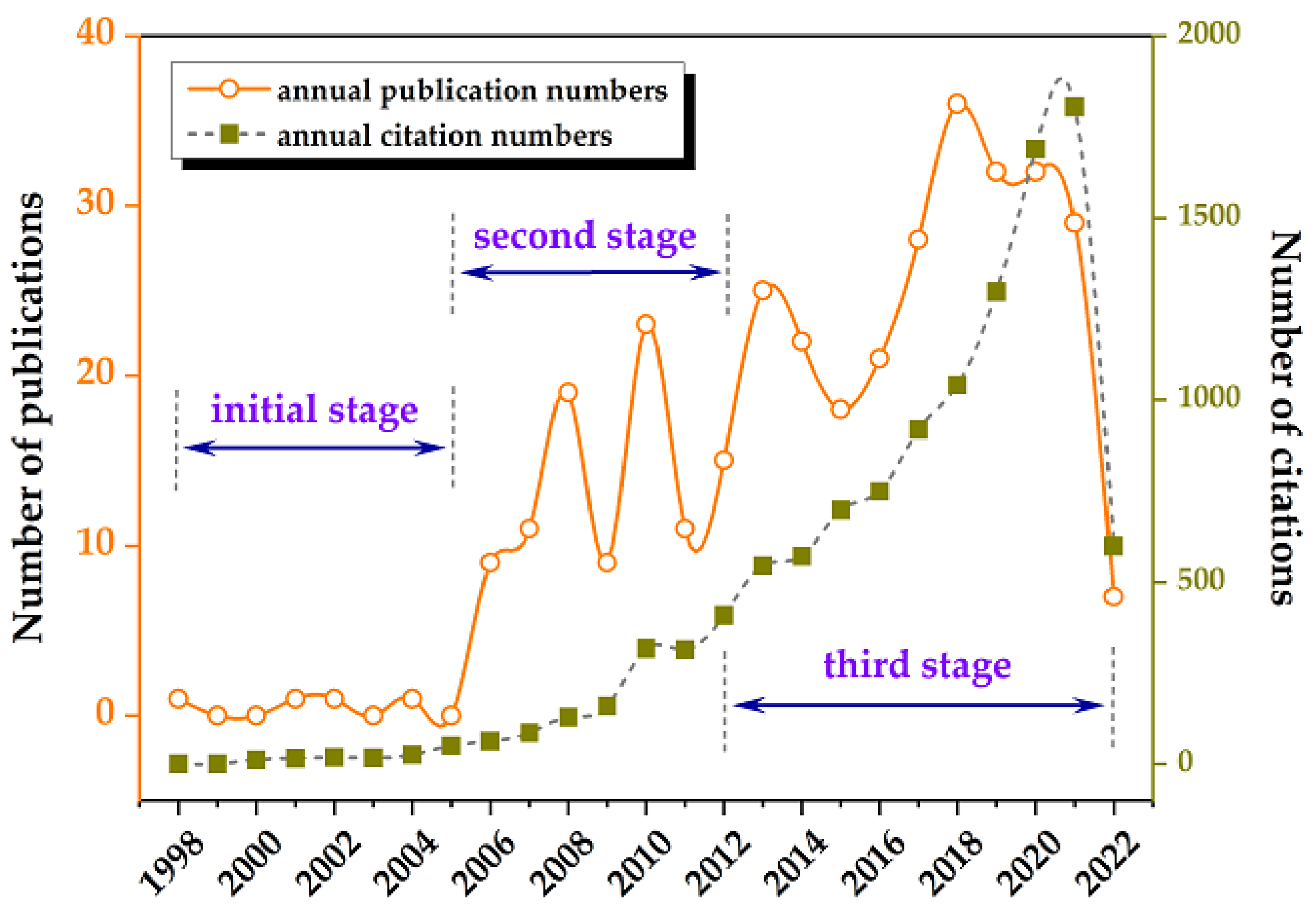
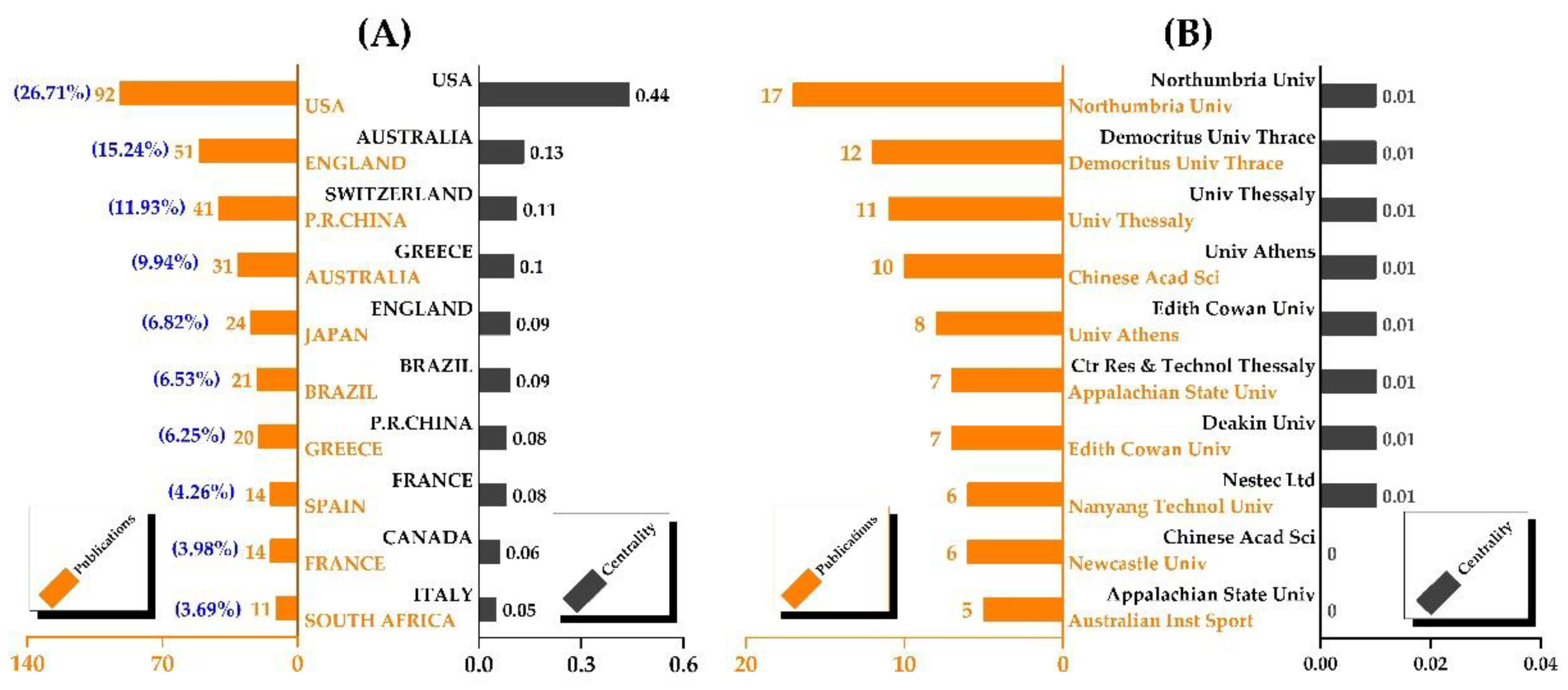
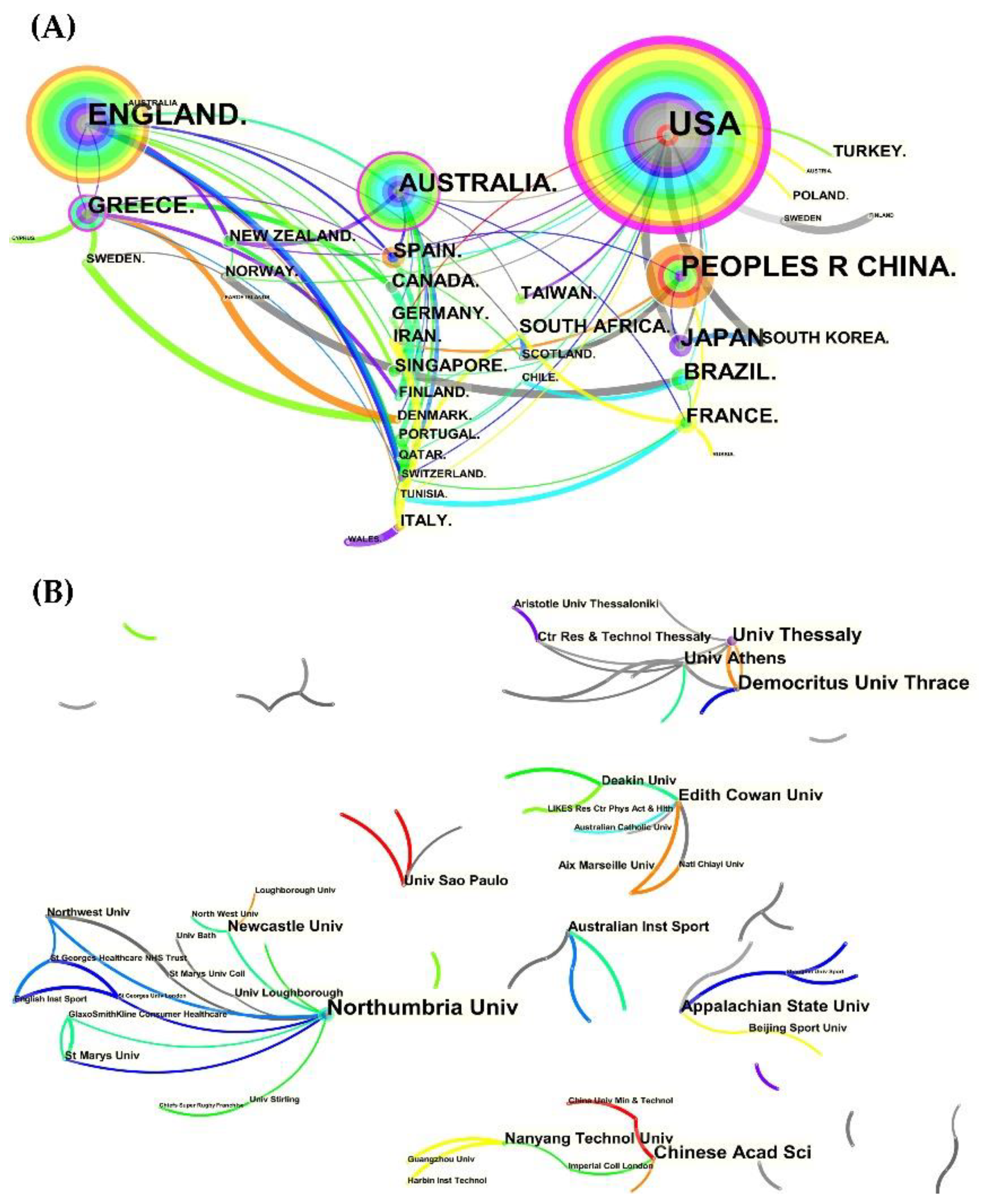
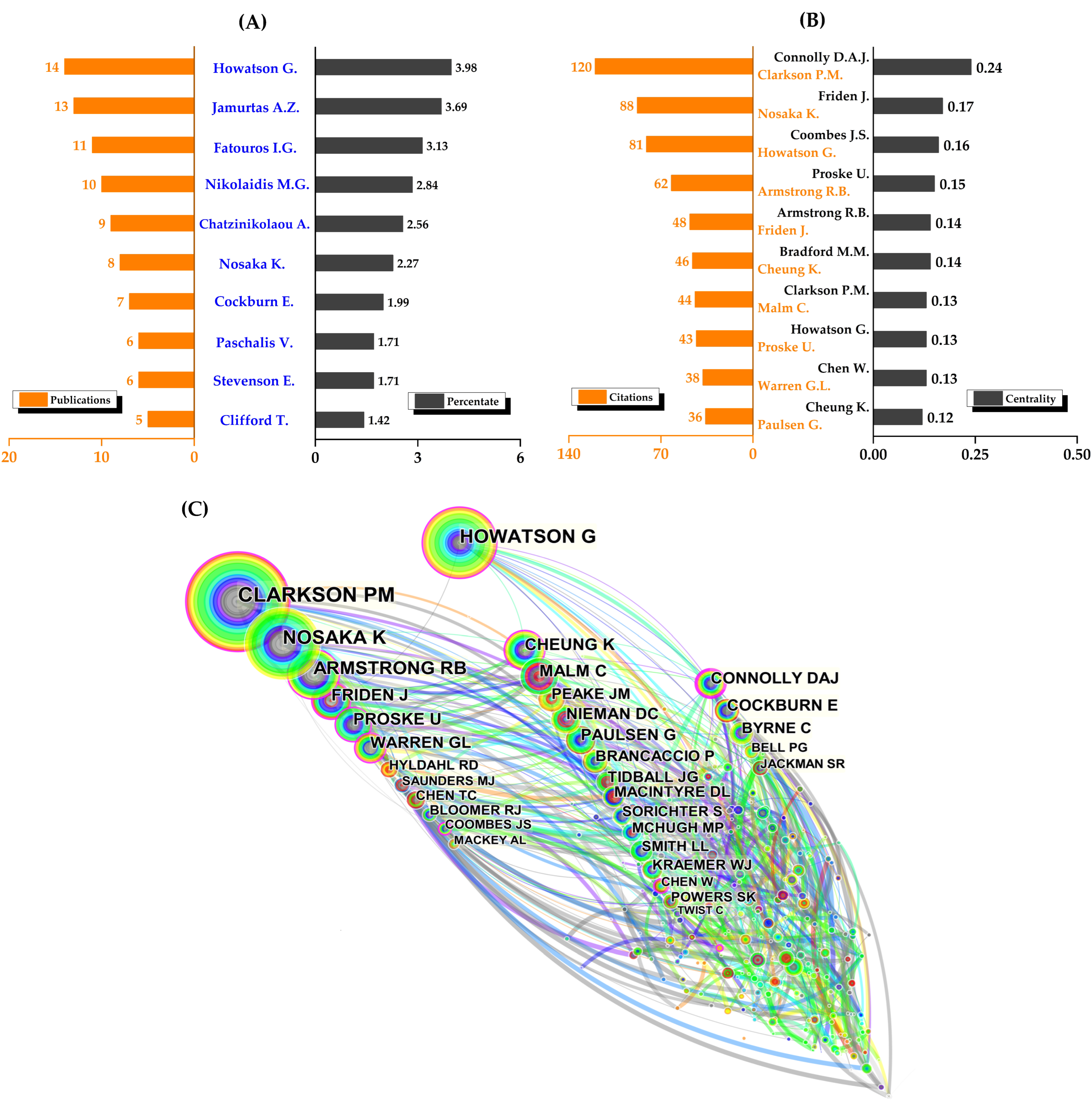
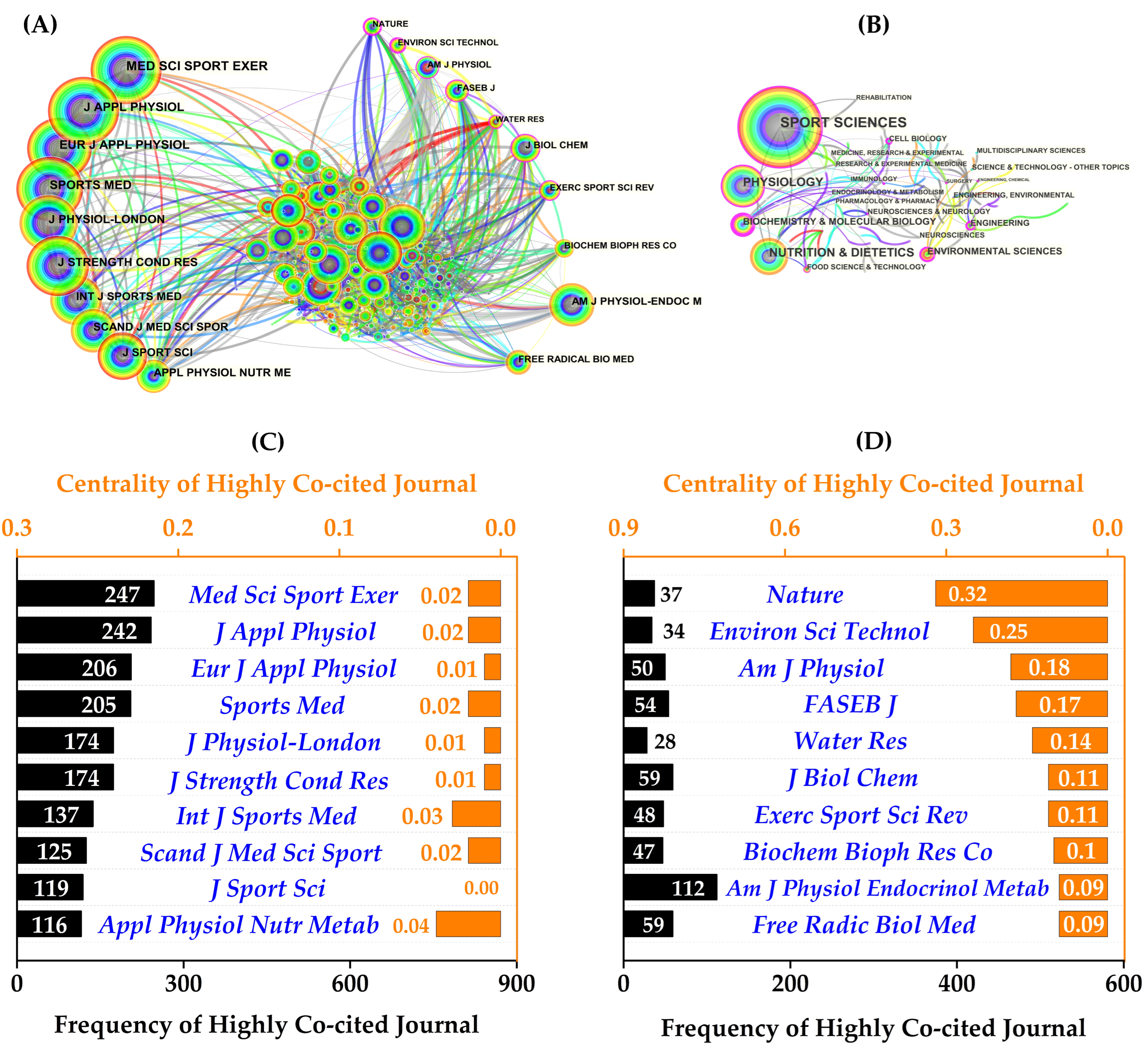
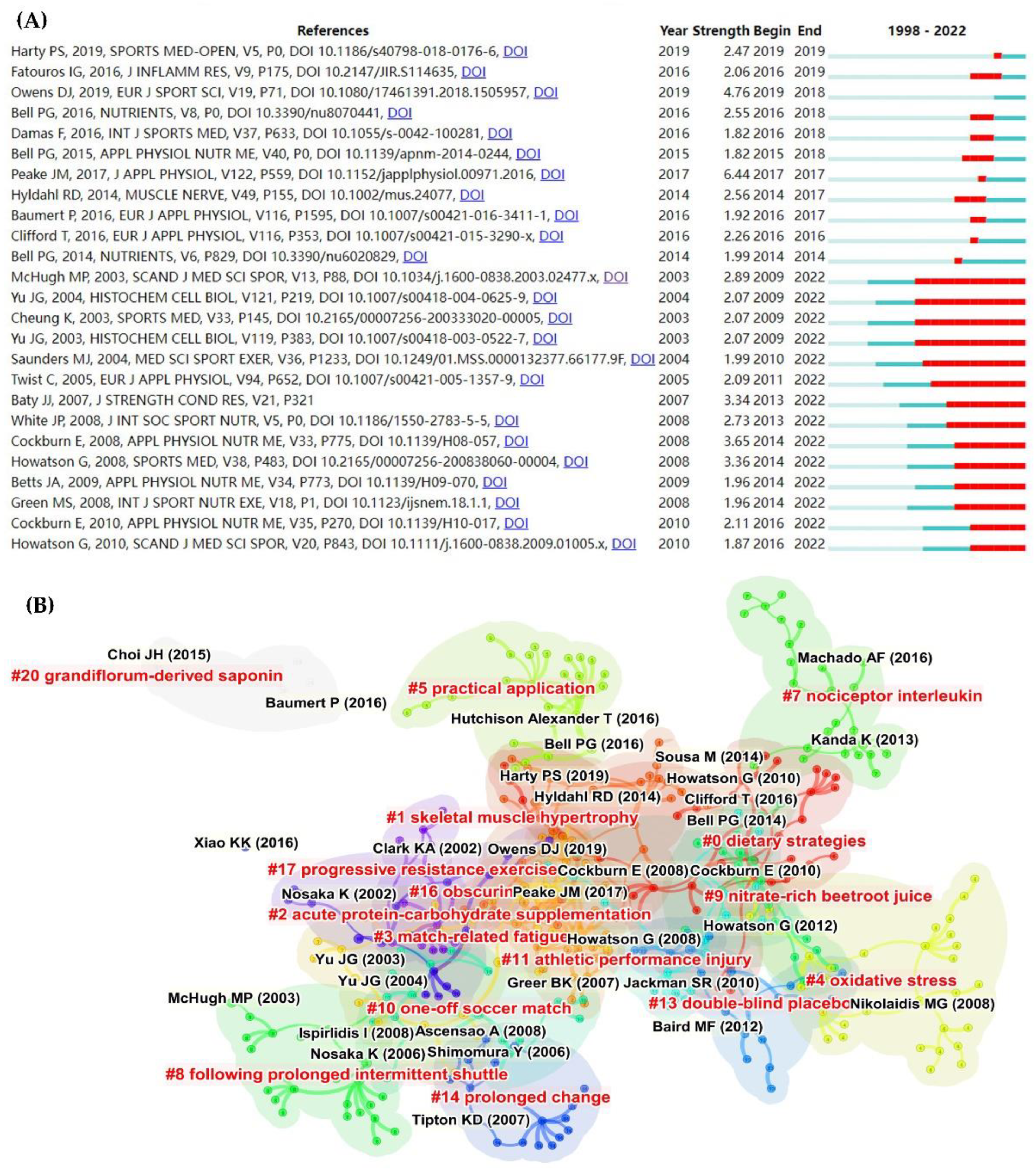
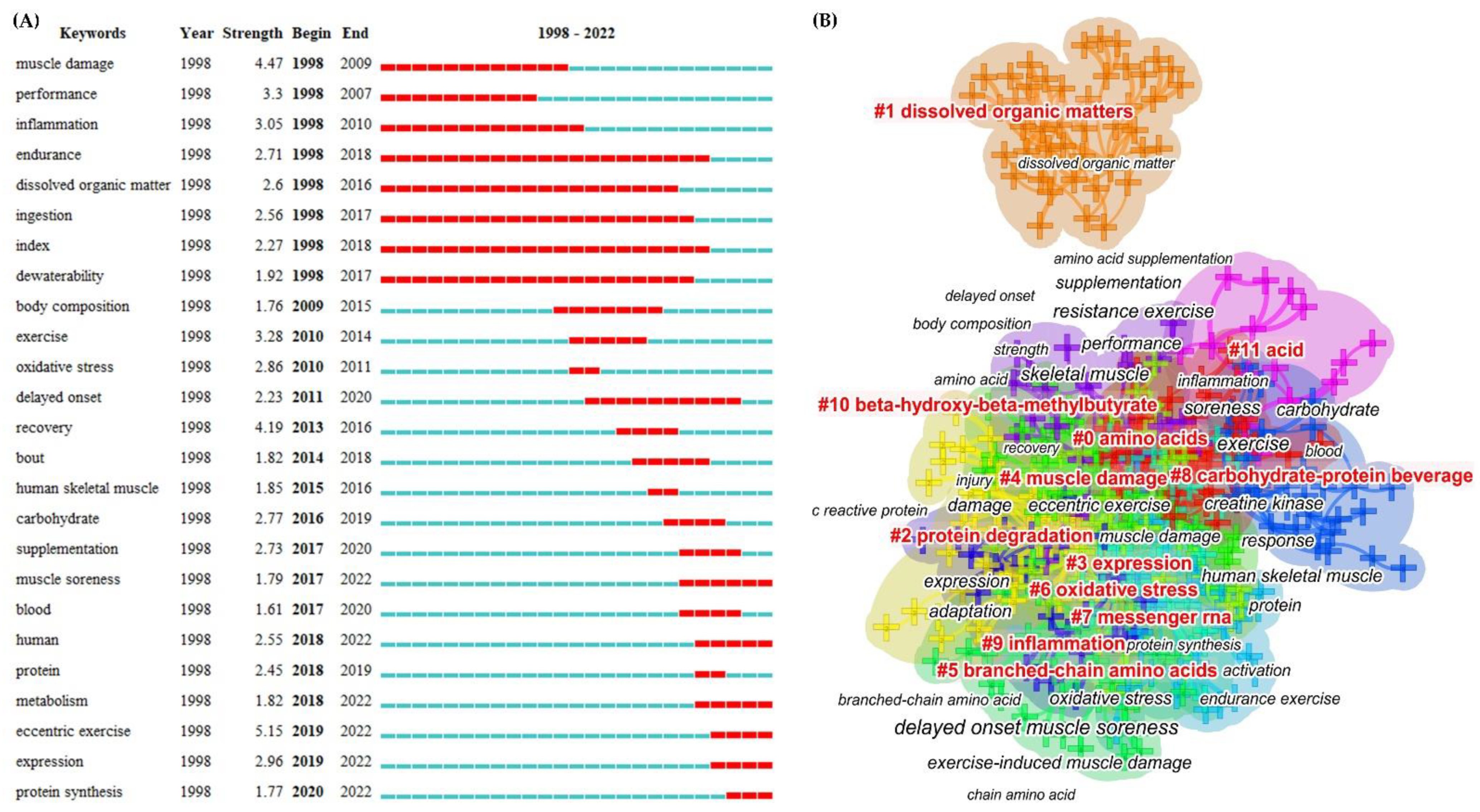
| Journal | Publications (%) | IF (2021) | H-Index | Country | Quartile in Category (2021) |
|---|---|---|---|---|---|
| Eur J Appl Physiol | 20 (5.68%) | 3.346 | 142 | Germany | Physiology/Q2; Sport Sciences/Q2 |
| Appl Physiol Nutr Metab | 16 (4.46%) | 3.016 | 95 | Canada | Nutrition & Dietetic/Q3; Physiology/Q2; Sport Sciences/Q2 |
| Med Sci Sports Exerc | 13 (3.69%) | 6.289 | 238 | United States | Sport Sciences/Q1 |
| J Strength Cond Res | 12 (3.41%) | 4.948 | 140 | United States | Sport Sciences/Q1 |
| J Int Soc Sports Nutr | 12 (3.41%) | 5.159 | 56 | United Kingdom | Nutrition & Dietetics/Q2; Sport Sciences/Q1 |
| J Appl Physiol | 10 (2.84%) | 3.880 | 240 | United States | Physiology/Q2; Sport Sciences/Q2 |
| Nutrients | 10 (2.84%) | 6.706 | 143 | Switzerland | Nutrition & Dietetics/Q1 |
| J Sport Sci | 7 (1.99%) | 3.943 | 145 | United Kingdom | Sport Sciences/Q2 |
| Eur J Sport Sci | 6 (1.71%) | 3.980 | 65 | United Kingdom | Sport Sciences/Q2 |
| Front Physiol | 6 (1.71%) | 4.755 | 122 | Switzerland | Physiology/Q1 |
| Title | First Author (Country) | Journal | Citations | Acritical Type, Year of Publication |
|---|---|---|---|---|
| Exercise-induced muscle damage in humans [1] | Clarkson P.M. (USA) | Am J Phys Med Rehabil | 840 | Review, 2002 |
| The prevention and treatment of exercise-induced muscle damage [10] | Howatson G. (UK) | Sports Med | 302 | Review, 2008 |
| Eccentric exercise-induced injuries to contractile and cytoskeletal muscle fibre components [29] | Fridén J. (Sweden) | Acta Physiol Scand | 268 | Review, 2001 |
| Time-course of changes in inflammatory and performance responses following a soccer game [30] | Ispirlidis I. (Greece) | Clin J Sport Med | 243 | Original article, 2008 |
| Muscle damage and inflammation during recovery from exercise [31] | Peake J.M. (Australia) | J Appl Physiol | 229 | Review, 2017 |
| Exercise promotes BCAA catabolism: Effects of BCAA supplementation on skeletal muscle during exercise [32] | Shimomura Y. (Japan) | J Nutr | 213 | Review, 2004 |
| The cytokine response to strenuous exercise [27] | Pedersen B.K. (Denmark) | Can J Physiol Pharmacol | 188 | Review, 1998 |
| Massage therapy attenuates inflammatory signaling after exercise-induced muscle damage [16] | Crane J.D. (Canada) | Sci Transl Med | 168 | Original article, 2012 |
| Nutraceutical effects of branched-chain amino acids on skeletal muscle [35] | Shimomura Y. (Japan) | J Nutr | 159 | Original article, 2006 |
| Influence of cold-water immersion on indices of muscle damage following prolonged intermittent shuttle running [17] | Bailey D.M. (UK) | J Sports Sci | 143 | Original article, 2007 |
| Title | First Author | Journal | Centrality | Acritical Type, Year of Publication |
|---|---|---|---|---|
| Effect of milk-based carbohydrate-protein supplement timing on the attenuation of exercise-induced muscle damage [33] | Cockburn E. (UK) | Appl Physiol Nutr Metab | 0.29 | Original article, 2010 |
| The prevention and treatment of exercise-induced muscle damage [10] | Howatson G. (UK) | Sports Med | 0.23 | Review, 2008 |
| Acute milk-based protein-CHO supplementation attenuates exercise-induced muscle damage [34] | Cockburn E. (UK) | Appl Physiol Nutr Metab | 0.20 | Original article, 2008 |
| Montmorency cherries reduce the oxidative stress and inflammatory responses to repeated days high-intensity stochastic cycling [36] | Bell P.G. (UK) | Nutrients | 0.19 | Original article, 2014 |
| Dietary strategies to recover from exercise-induced muscle damage [11] | Sousa M. (Portugal) | Int J Food Sci Nutr | 0.16 | Review, 2014 |
| Delayed onset muscle soreness: treatment strategies and performance factors [5] | Cheung K. (New Zealand) | Sports Med | 0.15 | Review, 2003 |
| Exercise-induced muscle damage: What is it, what causes it and what are the nutritional solutions? [6] | Owens D.J. (UK) | Eur J Sport Sci | 0.14 | Review, 2019 |
| Effects of dietary carbohydrate on delayed onset muscle soreness and reactive oxygen species after contraction induced muscle damage [37] | Close G.L. (UK) | Br J Sports Med | 0.13 | Original article, 2005 |
| Effects of a carbohydrate-protein beverage on cycling endurance and muscle damage [38] | Saunders M.J. (USA) | Med Sci Sport Exer | 0.13 | Original article, 2004 |
| Does exercise-induced muscle damage play a role in skeletal muscle hypertrophy? [14] | Schoenfeld B.J. (USA) | J Strength Cond Res | 0.13 | Review, 2012 |
Publisher’s Note: MDPI stays neutral with regard to jurisdictional claims in published maps and institutional affiliations. |
© 2022 by the authors. Licensee MDPI, Basel, Switzerland. This article is an open access article distributed under the terms and conditions of the Creative Commons Attribution (CC BY) license (https://creativecommons.org/licenses/by/4.0/).
Share and Cite
Xu, F.; Zeng, J.; Liu, X.; Lai, J.; Xu, J. Exercise-Induced Muscle Damage and Protein Intake: A Bibliometric and Visual Analysis. Nutrients 2022, 14, 4288. https://doi.org/10.3390/nu14204288
Xu F, Zeng J, Liu X, Lai J, Xu J. Exercise-Induced Muscle Damage and Protein Intake: A Bibliometric and Visual Analysis. Nutrients. 2022; 14(20):4288. https://doi.org/10.3390/nu14204288
Chicago/Turabian StyleXu, Fei, Jinshu Zeng, Xuan Liu, Jiaming Lai, and Jing Xu. 2022. "Exercise-Induced Muscle Damage and Protein Intake: A Bibliometric and Visual Analysis" Nutrients 14, no. 20: 4288. https://doi.org/10.3390/nu14204288
APA StyleXu, F., Zeng, J., Liu, X., Lai, J., & Xu, J. (2022). Exercise-Induced Muscle Damage and Protein Intake: A Bibliometric and Visual Analysis. Nutrients, 14(20), 4288. https://doi.org/10.3390/nu14204288






